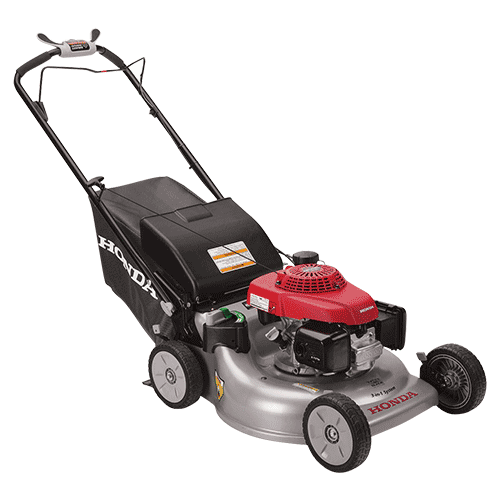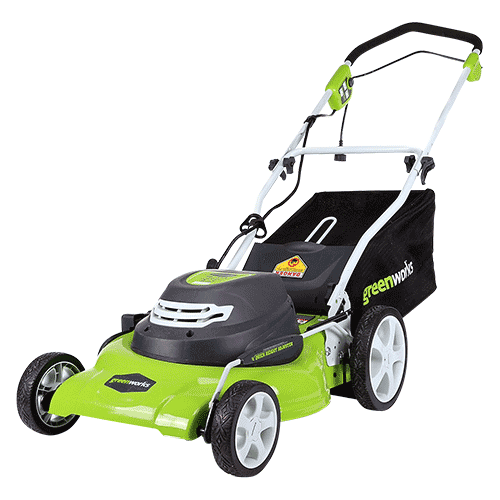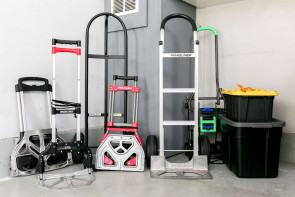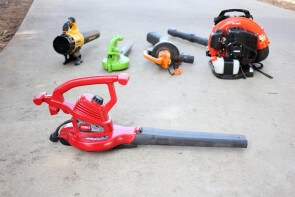
The Best Lawn Mowers
After spending a whole season mowing a 4,300 square-foot lawn with self-propelled gas, electric and manual lawn mowers, we’ve selected the Honda – 21″ HRR216K9VKA as the best lawn mower. With a 160cc engine, the Honda’s cord-free, self-propelled operation gives you plenty of power to get through weeds and overgrowth. If you’ve got a smaller lawn and you don’t want to deal with gasoline and engine maintenance, the Greenworks – 22502 electric is a great option.
After spending a whole season mowing a 4,300 square-foot lawn with self-propelled gas, electric and manual lawn mowers, we’ve selected the Honda – 21″ HRR216K9VKA as the best lawn mower. With a 160cc engine, the Honda’s cord-free, self-propelled operation gives you plenty of power to get through weeds and overgrowth. If you’ve got a smaller lawn and you don’t want to deal with gasoline and engine maintenance, the Greenworks – 22502 electric is a great option.
Table of contents
- The 6 lawn mowers we tested
- 1. Best self-propelled gas mower: Honda – 21″ HRR216K9VKA
- 2. Best electric mower: Greenworks – 22502
- 3. Best manual mower: Fiskars – Staysharp Max
- Other products we tested
- How we selected
- How we tested
- Important features to consider
- How to properly mow a lawn
- Gas vs. electric vs. manual mowers
The 6 lawn mowers we tested
| Product | Price | Type | Push Assist | Overall Rating |
|---|---|---|---|---|
| 1. Honda - 21" HRR216K9VKA | $$$$ | Gas | Yes | 5/5 |
| 2. Greenworks - 20" 22502 | $$ | Electric | No | 4.5/5 |
| 3. Fiskars - 18" Staysharp Max | $$$ | Manual / Reel | No | 4.5/5 |
| 4. Toro - 22" Recycler 20334 | $$$$ | Gas | Yes | 5/5 |
| 5. Sun Joe - 14" MJ401E | $$ | Electric | No | 4/5 |
| 6. Great States - 16" 415-16 | $$ | Manual / Reel | No | 4/5 |
1. Best self-propelled gas mower: Honda – 21″
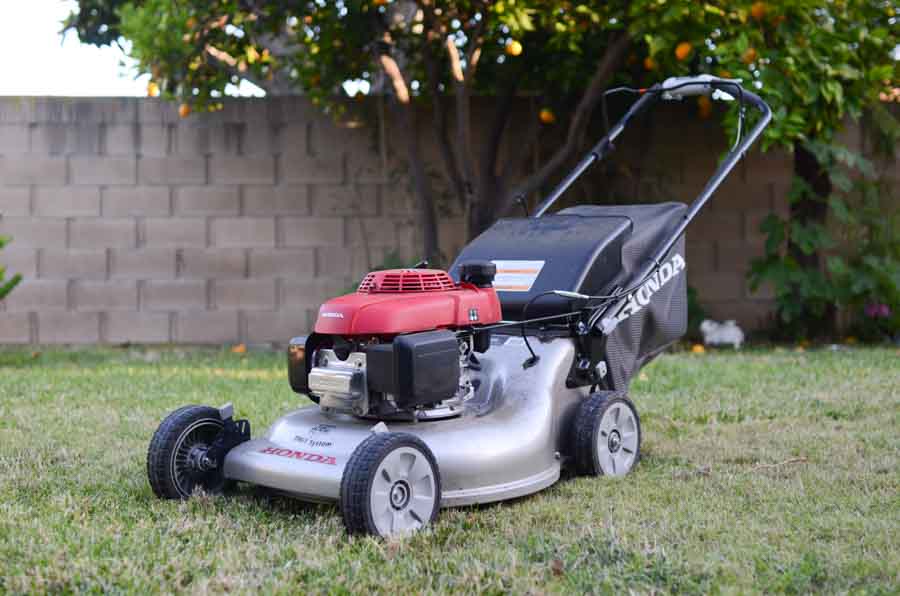
Honda seems to have discontinued our winning pick but has released a new model that seems almost identical in features. The changes seem to be a different engine, adding 1 more height option, and a darker paint on the body. We have adjusted all the links to point towards the newer item.
Both models of self-propelled gas mower that we tested are well-built machines. This was a very close call, but Honda – 21″ has included design and ergonomic considerations that make it a better mower.
Honda has models in the $500 and $600+ range which add features and functions you may be interested in: electric starting or the option to stop the blade and idle down the engine rather than shutting off and re-starting every time you need to stop, for example. We stuck to our $400 budget and feel confident that most will be happy with the performance of this machine on an average lawn like ours.
Honda engines have a reputation for easy starting and this one is no exception. Even with just a pull-start (and needing to re-start every time we stopped to pick up a piece of debris), we never had any trouble getting this mower going.
Self-propelled mowers are heavy and can cause damage in wet soil when making a tight turn. Turning while in motion was very manageable on the Honda, but avoiding lawn damage with a heavy mower requires getting to know the wet spots on your lawn and developing a feel for the balance of the mower.
We tested the mowers in wet grass to see how they’d fare, and the Honda did stall on the wettest grass we tested — probably because the chute clogged up with the wet clippings we were bagging. Other reviewers claim their machine didn’t stall with wet grass, but very wet grass is definitely not something any mower is designed for.
After running electric mowers and manual mowers, the Honda was definitely louder, but it’s not like a straight-pipe Harley or a chainsaw.
Adjusting cutter height requires individual settings on each wheel — this is a bit annoying, but most people won’t have to adjust often.
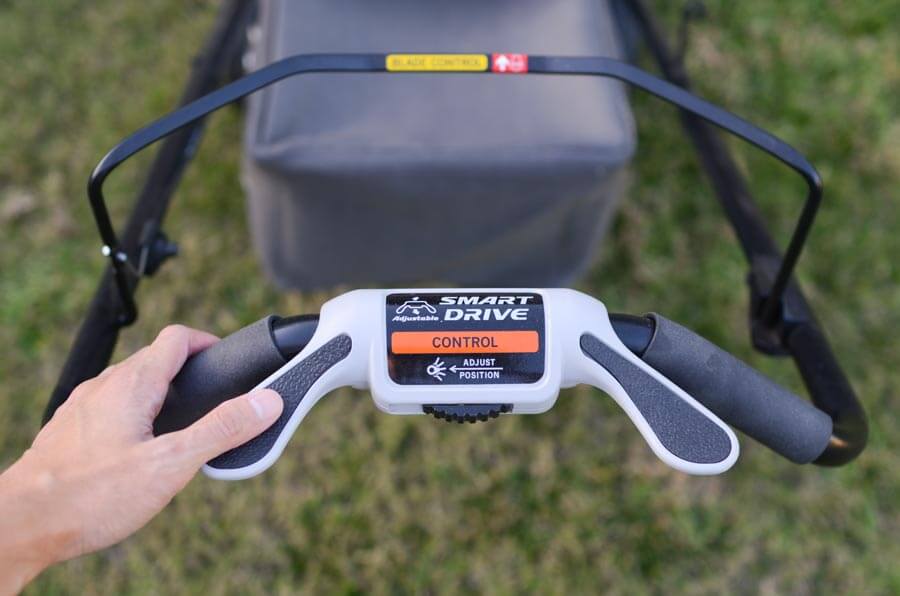
Since the mower is pulling itself forward whenever the engine is going, variable speed control helps for working slowly around turns or near edges of a curb. Honda’s thumb-controlled walk-speed setting was easy to use and felt more natural than the “personal pace” adjuster on the Toro, which was another mower we tested.
Honda’s switch controlling the bagging/mulching flap is also nicer than the Toro’s lever, with a solid engagement that clicks reassuringly in place. Honda claims that their blade system cuts better with two blades, but with a yard the size of the one we tested it was difficult to tell the difference. Suffice it to say, the Honda and Toro both cut well.
The foldable handle has quick-release locks for folding and storing the handle, whereas the Toro uses spin-off fasteners that take more time. Honda also includes padding on the handles of their machine, where Toro leaves you with plastic.
We stored our mowers in a raised shed in the backyard. The shed isn’t super roomy, so storage size and maneuverability were something we noticed. At 84 pounds the Honda is still light enough to lift on its back wheels to roll in, but lifting it to move around in a tight space is noticeably more difficult than with the non-gas models.
Key takeaways:
- The Honda – 21″ HRR216K9VKA gave us trouble-free performance the first time and every time. No trouble with the pull-starter, the bagging system, or the blade adjustment.
- This mower is powerful enough to take on wet grass and mulches whatever twigs and leaves are on your lawn.
- While it’s hefty compared to electric or manual-powered mowers, Honda designed a handle-folding system that makes it relatively easy to store.
2. Best electric mower: Greenworks – 22502

Compared to the heavy gas mowers the Greenworks – 22502 electric powered mower feels incredibly light: at 56 lb, it’s about 30 lb lighter than the Honda. This makes it far easier to turn without skidding, not to mention easier to handle when you’re putting it away. There’s a lot of plastic involved in keeping that weight down, of course, but the Greenworks still feels more like a serious lawn mower than the other electric model we tested. It’s a simple machine and doesn’t need unnecessary bulk.
The Greenworks mower has a 20-inch mowing width and height can be adjusted from 1.5 inches to 3.75 inches with seven height settings total. In the price range we tested, most electric mowers cut a much narrower track (the Sun Joe is a 14-inch and a comparable Black and Decker model is 15 inches) which means you’ll finish 20-30 percent more quickly with the Greenworks.
The Greenworks came ready to go for bagging, side discharge, and mulching, where the Sun Joe only lets you bag unless you buy extra accessories. Setup was a piece of cake, though we should note that the box it came in was not taped shut — the outer shipping box was secure and nothing was missing, but it was a possible sign of lax shipping quality control.
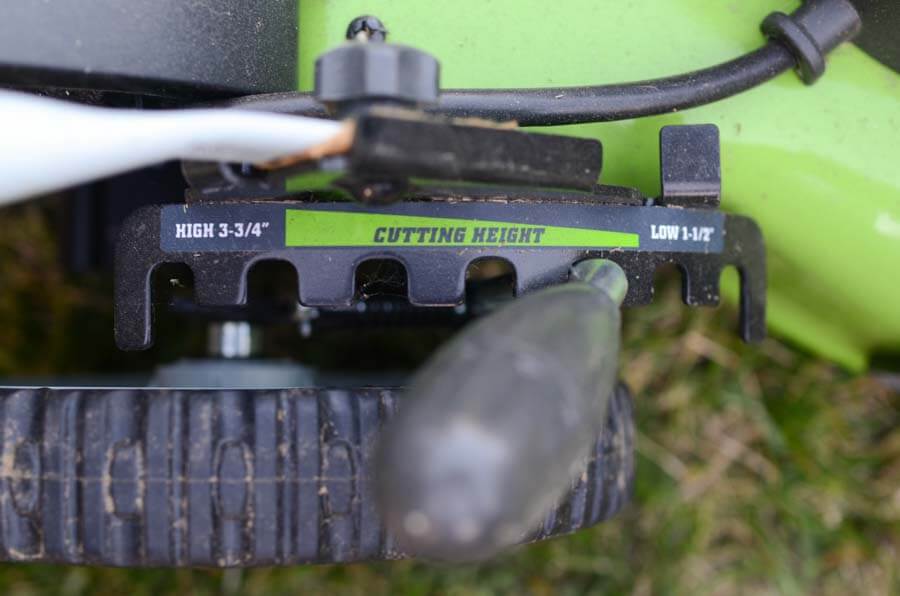
Greenworks made height adjustment very easy: adjusting one lever controls cutting height on the entire mower. On the other hand, the Sun Joe required individual wheel adjustments, as did the gas-powered models we tested.)
This mower has a side discharge chute, but it requires an attachment to keep open. You have to insert a plug in the back of the mower and add the chute on the side to spread clippings to the side.
One of the disappointing things we noted was that clipping shreds occasionally spray out from the catch basket around the perimeter of the deck. This isn’t a big deal, but it’s not something that happened with other mowers.
Dumping the clippings can be slightly awkward since there’s a crossbar that supports the handles. This is an issue on both electric models we tested, but not on the gas models (which have larger, more robust handlebars that don’t use a cross-brace.) This doesn’t stop you from removing the bag, but you have to be aware of where your hands are and bend in awkward ways.
Mowing with an attached power cord is not fun. You’re chained to the plug, dancing a tango with the mower to avoid the cable getting clipped. It’s manageable if you start near the plug and work going away from the cord, but annoying to say the least. Water in pools or puddles is also an electricity-related hazard you’ll have to pay attention to with a long cord.
Note that the Greenworks mower doesn’t come with an extension cord; you’ll need to buy a fairly heavy cord, at least 14 gauge if you’re going longer than 50 feet. 16GA is okay at 50 feet, but you’ll want something longer than that unless you have electrical outlets on every corner of your lawn. You’ll also have to coil the cable carefully after you use it, either a careful straight coil or over-under, unless you want to spend time every week untying a bunch of knots and dealing with a spiral-shaped cord after a year of twisting and untwisting it from sloppy coils.
We felt this mower was ideally sized for our lawn and having no exhaust fumes was great, but it still made a lot of noise relative to manual mowers. Plus, we really missed being cord-free after our time with the gas mowers.
Key takeaways:
- Like any electric mower, the Greenworks – 22502 20″ mower is lighter and easier to maneuver, but you’re tied to an electrical cord.
- Greenworks gives you a lot of mower for your money; it’s much more efficient and better built than the other electric mower we tested.
- It’s not as quiet as the manual mowers, but not having to deal with the noise and smell of a gasoline engine is a huge plus.
3. Best manual mower: Fiskars – Staysharp Max
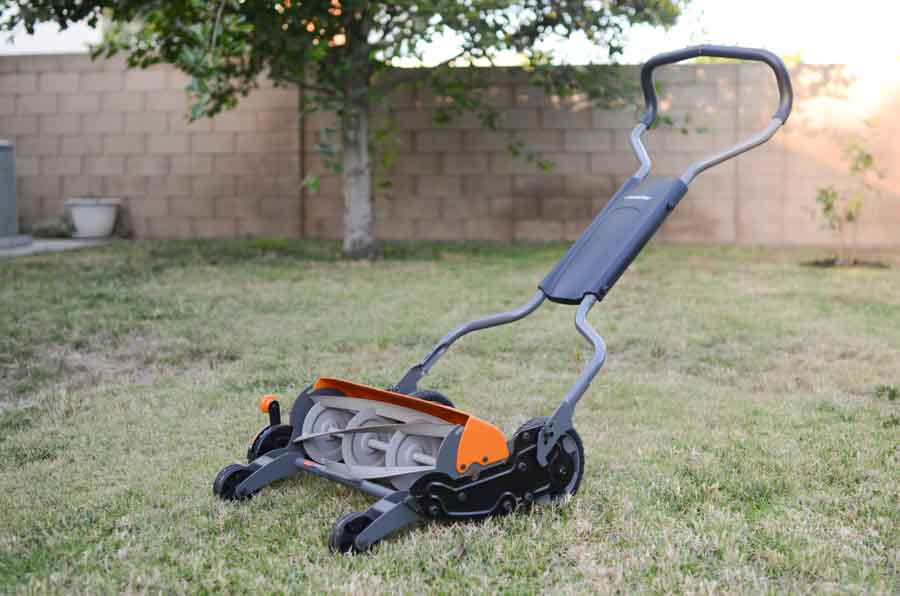
The Fiskars – Staysharp Max is wonderfully simple. It’s solid and precise. Plus, with an 18-inch wide reel it covers ground more quickly than even the Sun Joe electric mower we tested (the Fiskars also costs more though.) Manual mowers use a scissor-like blade system that usually makes a grinding or swishing noise, but Fiskars takes pride in their carefully aligned blades and resulting lack of noise.
Before starting we knew we were going to be in love with manual mowers for the eco-friendly aspect, quiet operation, and lack of gas exhaust. The Fiskars mower was indeed very enjoyable to cut with.
A quiet mower means you don’t feel guilty bugging your neighbors if mowing early in the day or late in the evening. A great perk is that you can talk on the phone or listen to music with non-sealing earbuds while mowing with this machine.
We wore gloves while mowing (since you need to be even more diligent about clearing debris with a manual mower) but were surprised at how comfortable the padded handles are on the Fiskars.
Fiskars went for a very wide cutting area, two inches wider than the Great States mower. This lessens cutting time, but all that width makes it more cumbersome to maneuver in the shed. We feel that it’s well worth the tradeoff and had no issues maneuvering on the turf.
Out of the box, setup was pretty simple, requiring a few screws to connect the handles to the body. The handles fold up (without locking), which saves space, making storage easy compared to non-folding handles.

Adjusting height on this mower is even easier than on the gas-powered models — it’s just one lever in the front instead of adjusting four wheels individually. It’s also marked at 1 inch (shortest) to 4 inches cutting height. On other models you kind of just have to know the height range and wing it, so this was a nice touch on the Fiskars.
To give this manual mower a workout, we used the 1.5-inch setting on overgrowth at first. It was easy in some parts, but extremely difficult towards the end, in patches that weren’t even super tall. On subsequent mowings, it was a breeze. Unlike with gas or electric mowers, you definitely have to spend more time clearing the lawn of twigs and debris before mowing so you don’t jam up the mower.
The adjustable chute can let you direct clippings forward or backward as needed. There’s no included bagging option and even with the optional clipping-catcher this mower can’t suck up and pulverize leaves and small twigs like the powered mowers can.
With extra lawn-clearing time and smaller cutting width, a manual mower can be more work and will take longer than powered lawn mowers. However, if you’re trying to reduce your carbon footprint and don’t ever let your grass get overgrown, this may be the mower for you.
Key takeaways:
- Heavier than most manual mowers, the Fiskars Staysharp Max‘s 18-inch cutting width makes quick work of small lawns.
- Most manual mowers are somewhat quiet, but Fiskars has made a reel that’s almost noiseless.
- Great build quality, fit and finish; this mower is more expensive than a cheap plug-in mower and it shows.
Other products we tested
4. Toro – 22″ Recycler 20334

Immediately, we noticed the Toro 22″ Recycler’s excellent packaging: high-quality plastic wrap on all the parts and the engine keeps everything tidy during shipping.
While we appreciated the padding and a few control details on the Honda just a bit more, Toro really knows their stuff too. The handle and connectors on this mower are excellent.
One setup detail that lost Toro some points is how hard it is to add oil to the B&S engine and check the level. Waiting for the oil to drip down into the crankcase so you can read the dipstick accurately is a tedious process and the min/max markings on the dipstick are not present as depicted in the manual. Instead, there are only dots. There’s very little room for error, so setting up the mower for the first time involved a lot of waiting/re-dipping to make sure we got the right amount of oil.
We had trouble with the electric starting system, too. We charged the starter battery as directed, but it didn’t work. The instructions for initial startup weren’t especially clear, either. The starter button didn’t work in an intuitive way and the manual talks about a key-start that our mower doesn’t have. So for our review, the tester started the mower manually, just like the Honda. The Toro we tested does include the electric starter at the same price as the Honda with pull-start only.
Wheel height adjustment on the Toro isn’t as easy as other mowers. You have to adjust each wheel individually. Plus, the front wheel height adjustment tab was bent on the machine we received.
Eventually, the first Toro we got had to be exchanged, since the metal tab on a wire that looks up to the blade control lever was broken. This rendered the machine unable to start. Home Depot swapped this out for us without a problem.
Toro’s “personal pace” drive speed feature works just fine, but we preferred the thumb control of the Honda. On the Toro, you have to hold the fixed handle in one hand and control speed with another handle that slides up and down. It’s not difficult to use, but it’s not as easy as Honda’s system.
5. Great States – 16″ 415-16
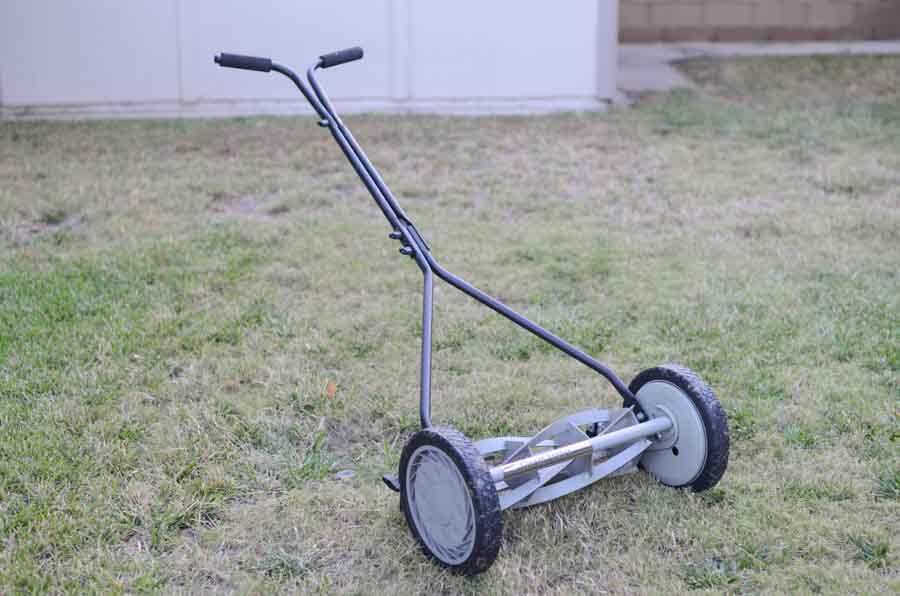
Unpacking the Great States – 16″ 415-16 mower was definitely a low point. Terrible setup instructions meant we had to undo the assembly we’d already done to fit the handles into the lower mower part. The plastic twist knobs that hold the handle fasteners together are poor quality, to say the least. In fact, you could cut yourself while tightening them. That being said, it’s a tool-free setup process.
At 16 inches of cutting width, (two inches less than the Fiskars, but much lighter overall), this machine is definitely more maneuverable. The quality of build feels lower than Fiskars, but not too bad considering it’s less than half the cost.
The cutting height on the Great States ranges from 0.5 inch to 2.5 inches compared to the Fiskars’ 1-4 inches. You really don’t need the 4-inch range unless you are cutting down overgrowth, but this might matter in a few cases.
The lack of motor noise and exhaust is still a great reason for choosing this manual model, but the cutting blade makes a grinding sound that’s louder than the Fiskars precisely adjusted cutter. The Great States is also slightly harder to push than the Fiskars.
This is a tool that gets the job done for less than $100 and will likely last for many years (with a design that’s been around longer than you probably have.) There are even folks with yards larger than ½ acre who happily use this machine to mow. When it comes down to details, though, the Fiskars is a much nicer mower.
6. Sun Joe – 14″ MJ401E

Setting up the Sun Joe 14″ MJ401E was drama-free, with a good (non-folding) attachment design for the surprisingly comfortable padded handles, but the budget price shows through: This mower looks and feels like a toy. While it is more agile than most of the other mowers, it is very plastic, very light, and very basic. At about $40 less than our winning electric model, this should be treated as a basic mower.
Sun Joe doesn’t even include the parts needed for mulching at this price point; If you only ever bag and need to stay within a low budget, this will get the job done. The relatively smaller clippings compartment fills up fast, though. We had to dump out 5-6 times on a small lawn, though that’s partly on account of some overgrowth we were chopping through.
Another disappointment was the very flimsy-feeling height adjuster, which uses a spring-loaded adjuster on each wheel axle and makes you turn the mower on its side to adjust. With three settings, it’s adequate for basic lawn care.
How we selected
For our lineup, we selected an assortment of manual, electric, and gas-powered mowers. As always, we tried to avoid products with consistently negative reviews that mention the same problems. We narrowed our selection to mowers from top brands with good reputations for warranty, reliability, and quality.
Lawn sizes have been shrinking. Recent census data shows that 95-percent of new houses sold have a lot smaller than ¼ acre (and the houses on those lots are getting bigger, leaving even less space for turf). So, we excluded riding mowers from our review and focused on the benefits of powered mowers relative to calorie-powered manual push mowers on a moderately-sized lawn.
We capped the price of the gas models at $400 since there were lots of good options. There are many other features to be had beyond that price range, but unless your lawn is bigger than 1/2 acre, it probably won’t make sense for you to spend much more.
How we tested
Our test lawns (front and back) total to around 4,300 square feet. We cut at the recommended height of 2.5 inches multiple times with each mower. Some mowers got a bit of an extra workout at the beginning of the season due to overgrowth, but we made sure to mow with them again once they reached normal heights to be fair.
Setup
Initial setup was one of the big differentiators for the mowers. Some had great instructions, while others were misleading and confusing. Each of these machines required some setup time since they come disassembled. The Great States mower stood out as most frustrating to set up.
Bagging
We tested the bagging feature on all the mowers that included it. We also compared all of the features used for normal lawn mowing including setup of the cutter height and ease of storage.
Overall usability
Weight and size were some of the most important factors that we noticed. A bulky mower is more difficult to store and transport and extra weight also requires some practice to get clean turns and avoid damaging lawns.
Important features to consider
Mower type – This is typically recommended by lawn size, but there are plenty of options; even within the broader gas/electric/manual categories there’s much to consider.
Bagging and mulching options – Some people will want to bag their clippings. We found that while all of these mowers are capable of bagging, you’d have to buy a separate attachment for the manual mowers. Overall, the design of the bigger self-propelled mowers made removing and emptying the clipping bag easier than the electric models.
Self-propel or push-assist – This makes the work much easier, but it comes with noise, smell, maintenance concerns, and a CO2 footprint. On the flip side, people-powered mowers are quiet and pollution-free, but they’re only efficient if you’re mowing on a rigid schedule to minimize the amount you’re cutting with each pass.
Electric-powered mowers – Electric motors offer great performance, but until battery technology can improve, these models require power cords which introduces a set of compromises compared to other style mowers.
Cutting-height adjustment – This is something most people won’t be adjusting frequently, but it’s still something you’ll have to deal with at least once on all mowers.
Cleaning and storage – This is another big usability consideration. Each mower has its own set of folding-handle quirks, plus nooks and crannies that need to be brushed out or washed off.
How to properly mow a lawn
Mowing a lawn often includes other maintenance aspects like perimeter cleaning with a string trimmer and clearing clippings or debris with a leaf blower which we cover on those respective articles Below we’ll stick to strictly mowing tips.
Direction
The “stripe” pattern clearly visible on most sporting fields comes from the fact that mowers push the grass over slightly while they trim and alternating directions when mowing will create contrast in the way those ‘rows’ of clipped grass reflect sunlight.
Generally, the back-and-forth stripe pattern is also the most efficient way for you to mow at home. If you start by mowing around the perimeter a few times, you’ll have some “headland” room to turn around at the end of each long row without fussing about grass you might miss when you turn.
Cutting in a concentric spiral pattern from the outside perimeter is also viable if you’re looking to minimize the stripe effect; Some also find the right-angle corners easier than 180° turns.
(If you really want to get fancy, reel mowers or powered mowers with a roller attachment push the grass flat enough to create the contrast needed for the intricate patterns you sometimes see on ball diamond outfields. David Mellor, groundskeeper for Fenway Park, even wrote a book on the subject.)
The best practice is to rotate your mowing pattern 90 degrees (start at a right angle to your previous pattern) every few mowings to keep grass from being pushed down too much in one direction.
Types of grass
There are basically two “regions” of grass-growing in the United States: “warm-season” grasses in the South, “cool-season” grasses in the North, and a narrow “transitional zone” where it’s common to cross-seed types from both regions.
Seed producers like Pennington and Scotts have lots of great info about the different varieties you might have in your yard. It’s a good idea to get to talk with a lawn-care professional in your area who can help you understand the quirks of growing locally (especially weeds and disease).
The biggest difference between these regions and the varieties you’ll find there is in the timing of peak growth: warm-season grasses grow the most during the summer, then go dormant and turn brown during the cooler winter months; cool-season grasses grow the most in spring, slow down when it gets hot, then have another growth spurt in the fall before winter dormancy.
Grass height and mowing frequency
When you’re deciding how tall you want your grass, the most important thing to remember is that if your grass is too short, it can’t absorb sunlight. Photosynthesis doesn’t happen without leaf area, and all of the other qualities of good turf are dependent on that energy. Basically, longer is better for the health of the grass.
This is especially important in non-growing seasons: the grass will be stressed and needs plenty of leaf and root area (with stored energy from the growing season) to continue thriving. Mow when the air is cool and avoid mowing right before hot weather is in the forecast.
Some warm-climate species, like Bermudagrass, are cut as low as a half-inch on sporting fields. This requires daily mowing in quick-growth seasons, though. (And plenty of water to keep it healthy.) See our in-depth review we did on garden hoses too.
There’s another benefit to keeping lawn grass on the longer side. While the grass is soaking up all the sunlight with lush, long leaves, it’s keeping that sunlight away from any weeds that might be trying to start underneath.
As a rule of thumb, never remove more than a third of the leaf area in one mowing. So if you’re mowing down to two inches, mow again before the grass hits three inches. Pennington provides a handy chart of mowing height for common grass types.
Mulching grass vs. bagging

In very sandy soil mulching can cause some problems since there aren’t as many organisms to consume clippings, but in most cases mulching regular clippings back into the turf is highly recommended by grass experts and municipalities alike.
Earthworms, fungi, and other primary consumers in your lawn’s ecosystem thrive on the clippings and turn the mulch back into available nitrogen for your lawn. (So it’s not just easier than disposing of bags: it means less fertilizer!)
So long as you aren’t trimming off more than an inch of grass, and you aren’t mowing when it’s wet, the clippings should easily scatter down to soil level and form a helpful layer of worm-food. You can even mulch the leaves that fall off your trees!
All of the mowers we tested are mulch-ready except for the Sun Joe 401E, which requires an optional attachment to safely funnel the clippings (and any debris you may accidentally find in your grass) to the side. The other powered mowers will require a quick conversion from bag-mode with an included plug or a moveable flap.
Because bagging is occasionally beneficial (if you have to wait for your lawn to dry in the spring and the grass gets really long, for example) we also tested the bagging features of all the powered mowers. (Manual-power reel mowers aren’t very good at cutting tall grass, but you can get leaf-catcher attachments if you really don’t want to mulch.)
Mowing wet grass
While it’s good to mow when the air is cool, avoid mowing grass that is wet from watering or rainfall. When fibers in the leaves get wet they get tougher, so the cut takes more work and can leave a ragged edge on the leaf. It requires you to sharpen your blades more frequently, too.
Plus, if you’re mulching your clippings, wet mulch all over your lawn is just as bad as it sounds — clumpy and prone to get musty. If you don’t have a way to dispose of them within a few days, having bags of wet mulch sitting in your garage is even worse.
Mowing wet grass is just a bad idea. A little dew in the morning generally won’t slow you down much, but if the grass is soaked it’s best to wait for the sun to come out.
Mower maintenance
Mowers are tools and tools need to be taken care of if you want them to keep doing a job well. Storage in a clean, dry place should be a given, but there are a few specific tasks that you’ll have to get used to if you want a mower that will keep your lawn looking its best:
Sharpening
All cutting edges require routine sharpening, even mower blades. Plan on sharpening at least once a season if you don’t want to bruise or tear your grass. Checking the blades for uneven wear and other problems is smart, but checking the grass to see how well you’re cutting is the surest way to determine the condition of your mower blades.
Sharpening more than once a season should only be necessary if you’re cutting heavier material like a lot of twigs (or the bane of every mower, hidden gravel/sand leftover from winter snow piles.)
Fiskars claims that the steel and tight-tolerance design used in their reel mower will cut cleanly for the life of the mower, but they still sell a sharpening kit and it works like all the other reel-mower sharpening kits. An abrasive compound wears away high spots and leaves a keen edge when you spread it on the blades and run the reel backward against the stationary cutting bar. (If dismounting drive chains or spinning mower reels with a hand drill aren’t your idea of fun, you can usually find a local handyman or landscaper who will do the job for you.)
Powered mower blades have edges more like axes and you can sharpen them in nearly the same way. A vise or other clamp to hold the blade steady and a carbide scraper or good steel file are all you really need to bring the edge back to a chisel-shaped apex that will be able to slice paper and keep your lawn looking crisp and green.
Winterizing gas mowers and oil changes
If your lawn is covered in snow (or simply not growing) for more than a month every year, there are storage tasks you’ll need to remember for gas engines. Old gasoline can go stale or dry out and create a layer of varnish inside your engine. You need to either add a stabilizer to your mower’s gas tank and fill it before storage (pretty easy, but the mower will be heavy) or get all of the gas out of the system.
Like your car, a mower’s four-cycle gasoline engine uses oil for lubrication, but unlike your car, it doesn’t run the oil through a filter to clean out debris. Nearly everyone will recommend annual oil changes before storage as part of a winter routine.
Spark plugs in a mower should last for a long time, but you should check them annually or as directed in your owner’s manual. People fool themselves into replacing electrical components arbitrarily if mowers won’t start, but it’s well worth learning how to spot signs of failure as a part of annual maintenance.
Gas vs. electric vs. manual mowers

All the mowers we tested will cut well enough once the blades hit the grass. The biggest differences come down to how much effort is required from a homeowner to get there and cover ground efficiently.
Manual reel mowers
These are the greenest of mowers, powered by whatever you’ve had for breakfast. They’re relatively simple tools that do one job: they cut grass quietly and efficiently for as long as you can push them.
Beyond the sustainability and simplicity, they’re lighter and easier to store: no cord, no gas, no worries. If you like the idea of augmenting your lawn-mowing cardio with a bit more resistance, you should consider a reel mower.
The biggest weakness to the reel mower is that it’s not effective with thick or tall grass. This is a tool that will make you regret every time you forget to mow by making you work much harder. Have a lot of overgrown weeds? You’ll want to look elsewhere.
Electric mowers
If your lawn is big enough that just thinking about pushing a reel mower is exhausting, an electric-powered mower is one way to ease your burden without the weight, noise, smell, and maintenance concerns of a gasoline engine.
Even compared to the Fiskars Max, the electric mowers we tested were light and easy to maneuver. They’re still louder than the manual mowers, since there’s a 14-inch or 20-inch steel blade swinging around under the deck. However, your neighbors and family will still have less reason to complain about your Saturday-morning routine.
There’s not nearly as much to maintain on an electric mower as on a gasoline-powered mower, but keeping the deck clean and inspecting the cord for wear are still important tasks you’ll need to perform.
Managing the cord on an electric mower is similar to the annoyances of working with a household vacuum cleaner but on a larger scale. Running over the cord with the mower is, obviously, something you must never do. You also don’t want to trip on it, drop it in a pool, accidentally unplug it or plug it into a socket that can’t provide the 12 Amps of AC power needed by these engines.
Gas-powered self-propelled mowers
The bigger your lawn, the more you’ll appreciate the self-propelled mower: these machines are designed to help you cover a lot of ground quickly by pulling themselves along at up to four MPH. So, all you really need to do is steer.
The gas mowers we tested have engines that provide around five horsepower to get through thick or long grass. (These are very similar to the engines you’ll find on a small Go-Kart.) Naturally, having all of that internal combustion power at your fingertips also brings noise and smells that other kinds of mowers won’t have.
While your time mowing will be much easier, the biggest drawback to gas-powered mowers is in maintenance. Like a gas-powered car, these mowers need fuel, oil changes, and air filter and spark-plug checkups. Maintaining a small engine is very simple: you can do a mower oil change in minutes and even teach your kids how to do it. However, it’s not for everyone. Naturally, there are mechanics who will do all of these services for you, for a fee.
The bottom line
Mowing your own lawn is one of those rites of passage for do-it-yourself home ownership. Like other jobs you do around your house, it will save you money compared to professional care, but it may take you more time and involve more cursing than you expected. We hope one of these mowers will help make your weekly lawn chores more enjoyable and less frustrating.
If you’ve got a smaller lawn and you’re excited about the idea of a brisk walk back and forth across it every Saturday morning, the Fiskars is probably an ideal machine for you. Smooth, quiet and precise, like the scissors the company is famous for, the Staysharp Max reel mower can help you keep your lawn looking its best without the noise and complications powered mowers bring.
If you’ve got a few weeds that are invading your lawn or if you anticipate dealing with overgrowth after a wet spring, a powered mower will mean less straining — not to mention the time it’ll save. The Greenworks 22502 has a 20-inch cutting blade that lessen the number of rows you’ll need to walk. Plus, it’ll make quick work of just about any foliage found in an urban lawn-care setting. It’s ready to go for bagging out of the box, too.
And if you’ve got a lawn bigger than ¼ acre or if you think you’ll appreciate the one-switch conversion between mulching and bagging, the Honda HRR216K9VKA cuts a wide swath quickly and efficiently through leaves, twigs and tall weeds. A self-propelled machine takes a bit more maintenance than an electric, but annual oil changes might seem a small price to pay compared to the headache of dancing around a cord on a larger lawn.
More Reviews
The 11 Best Expandable Garden Hoses
Joey's Garden Expandable Hose
Magliner - HMK119UA4
Compare-N-Save
AMES - 2519500
Black+Decker - LST136W
Toro - 51621
Briggs and Stratton
The 12 Best Garden Hose Nozzles
SprayTec - 9-Pattern Sprayer
The 7 Best Indoor Watering Cans
Fasmov - 1-Gallon Plastic Watering Can
The 10 Best Garden & Pruning Shears
Felco - F-2
The 8 Best Outdoor Watering Cans
Novelty - 2-Gallon Plastic Watering Can
Briggs & Stratton - 02081


